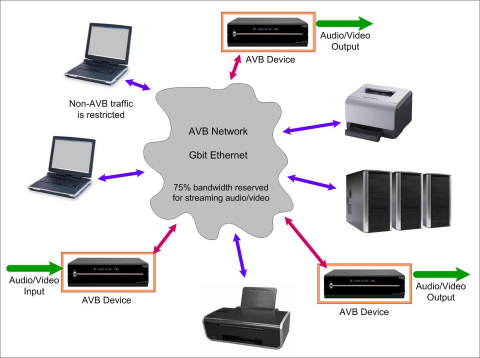
AVB Ethernet network
The IEEE 802.1AV Bridging Task Group established a set of new standards for audio and video networking on Ethernet. The AVnu Alliance is an industry forum promots the adoption of the IEEE 802.1 Audio Video Bridging (AVB). The Ethernet AVB consists of a collection of standards that enable audio and video to be streamed over ethernet.
802.1Qas
It is the standard for clock synchronization and time stamping and defines a precise timing protocol based on the IEEE 1558v2 protocol. Every device within the network shares a common global clock. The protocol allows devices to synchronise with this global clock within microseconds. It also supports media stream clock recovery and coordinates the AVB traffic control.
802.1Qav
It is the standard for switch packet prioritization and defines the buffering and forwarding of traffic through the network. Particular flow control algorithms are used. To synchronize traffic it uses the global clock provided by the 802.1Qas standard.
802.1Qat
The stream reservation protocol that provides the end-to-end reservation of bandwidth through an AVB network frpom sender to receiver.
The AVB network is characterized by:
- audio and video streaming with precise synchronization and low-jitter media clocks
- traffic shaping for media streams
- a reservation protocol that allows endpoint devices to notify various network elements in a path to reserve bandwidth to support a particular stream
- admission controls and identification of non-participating devices to restrict their traffic
The AVB network structure doesn’t require changes to the Ethernet lower layers and is compatible with all other functions of standard Ethernet switches. Most newer switches can be enabled for AVB by a firmware update.

The AVB system supports two classes of media streams based on the latency requirements:
- 2ms for low-latency applications (live audio and video transmission)
- 10 to 30 milliseconds for less critical applications
In an AVB Ethernet network the longest signal travel time is known throughout the entire network. Only a small amount of buffering is required and very low latencies of two milliseconds over seven switch hops in a 100 Mbps Ethernet network can be achieved. Using a Gbit network an even lower latency can be reached. The latency per switch (per hop) is roughly 25 microseconds.
In the network all AVB devices periodically exchange timing information to to precisely synchronize to the general clock. With this precise synchronization multiple streams can be synchronized and a common time base for sampling data streams at a source device and the destination device is provided. Within the network one device is set to be the grand master clock and all other devices synchronize their clocks with this master. All AVB in a network are master-capable.
The grand master clock can be overridden if the network is used in an environment requiring a house wordclock or video synchronization (genlock or trilevel sync).
The AVB Ethernet network implies full duplex connections to fulfill the requirement for minimal lost packets. There is no frame collision and all multiport devices function as bridges.
All non-AVB traffic does not have reserved bandwidth and ist bandwidth is constrained. Normally about 75% of the bandwidth in an AVB network are reserved for streaming data.